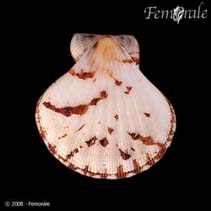Decatopecten amiculum (Philippi, 1851)
Cloak scallop| Native range | All suitable habitat | Point map | Year 2050 |

|
| This map was computer-generated and has not yet been reviewed. |
| Decatopecten amiculum AquaMaps Data sources: GBIF OBIS |
Classification / Names Common names | Synonyms | CoL | ITIS | WoRMS
Bivalvia | Pectinida | Pectinidae
Environment: milieu / climate zone / depth range / distribution range Ecology
Benthic; depth range 0 - 25 m (Ref. 348). Tropical
Distribution Countries | FAO areas | Ecosystems | Occurrences | Introductions
Indo-West Pacific: from East Africa, to the Philippines; north to southern Japan and south to the Malay Peninsula.
Length at first maturity / Size / Weight / Age
Maturity: Lm ? range ? - ? cm Max length : 6.0 cm SHL male/unsexed; (Ref. 348); common length : 5.0 cm male/unsexed; (Ref. 348)
Short description Morphology
Shell solid, small, nearly as long as high, inequivalve, the outline somewhat elongate dorsally and subcircular ventrally. Both valves convex, the right (lower) valve more inflated than the left (upper) valve which is moderately flattened towards the umbo. Ears small, subequal in size and shape. Right anterior ear with an obsolete anteroventral byssal notch, devoid of ctenolium. Outer sculpture of each valve with about 9 to 11 rounded radial folds, with numerous, much smaller secondary radial riblets that are finely lamellous on ribs or interspaces; transverse lamellous sculpture delicate and easily eroded on top of ribs. Hinge line short, about 1/3 to 1/2 of shell length, with rather strong oblique ridges and pits on either side of internal ligament. Interior of valves shiny , with a flattened radial sculpture corresponding with the outer folds. Colour: outside of shell off-white to beige, variously mottled with chestnut brown, tan or reddish purple, mainly on the left valve which is more vividly coloured than the often nearly uniform cream right valve. Interior whitish, frequently tinged with dark brown on hinge areas and broad rims, in 1 or both valves.
Life cycle and mating behavior Maturity | Reproduction | Spawning | Eggs | Fecundity | Larvae
Members of the class Bivalvia are mostly gonochoric, some are protandric hermaphrodites. Life cycle: Embryos develop into free-swimming trocophore larvae, succeeded by the bivalve veliger, resembling a miniature clam.
Main reference
References | Coordinator | Collaborators
Poutiers, J.M. 1998. (Ref. 348)
IUCN Red List Status (Ref. 130435: Version 2024-1)
CITES status (Ref. 108899)
Not Evaluated
CMS (Ref. 116361)
Not Evaluated
Threat to humans
Harmless
Human uses
| FishSource |
Tools
More information
Trophic Ecology
Food items
Diet
Food consumption
Ration
Predators
Diet
Food consumption
Ration
Predators
Ecology
Population dynamics
Growth
Age/Size
Length-weight
Length-length
Length-frequencies
Mass conversion
Recruitment
Abundance
Age/Size
Length-weight
Length-length
Length-frequencies
Mass conversion
Recruitment
Abundance
Life cycle
Distribution
Human Related
Aquaculture profile
Stamps, Coins Misc.
Stamps, Coins Misc.
Outreach
References
Internet sources
BHL | BOLD Systems | CISTI | DiscoverLife | FAO(Publication : search) | Fishipedia | GenBank (genome, nucleotide) | GloBI | Gomexsi | Google Books | Google Scholar | Google | PubMed | Tree of Life | Wikipedia (Go, Search) | Zoological Record
Estimates based on models
Preferred temperature
(Ref. 115969): 24.9 - 29.2, mean 28.6 (based on 2234 cells).



